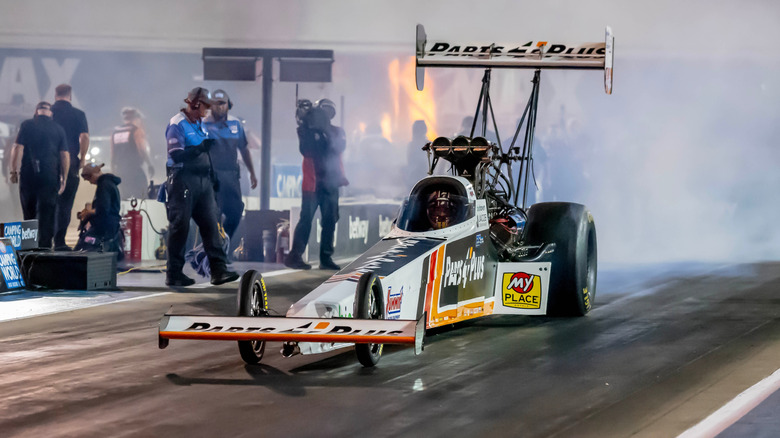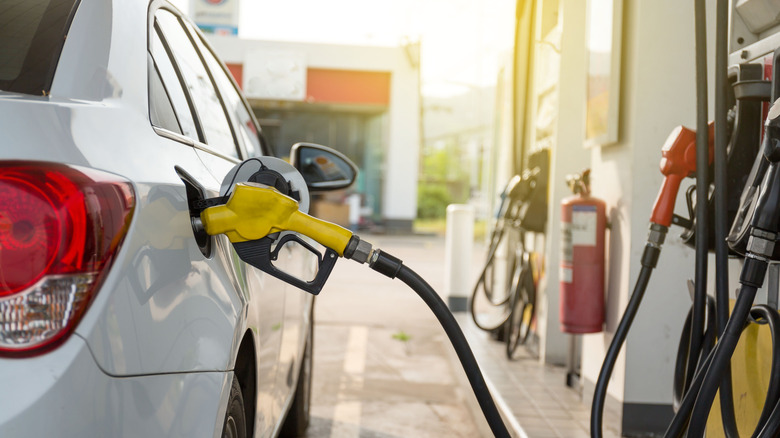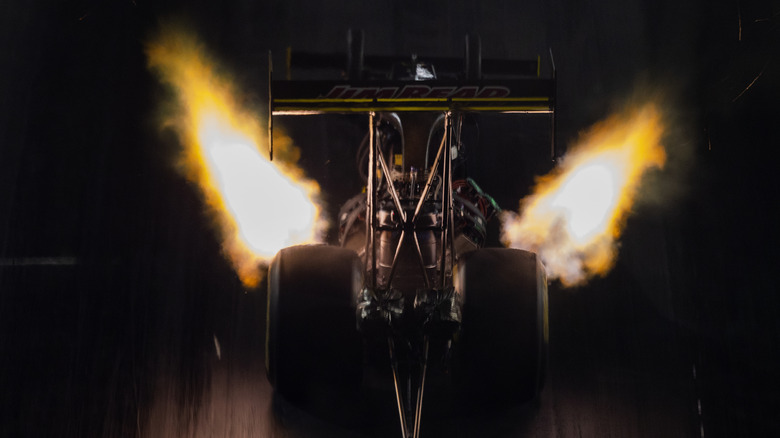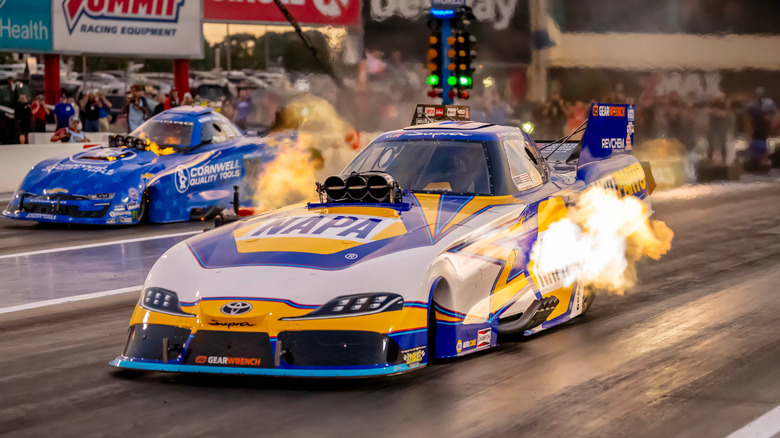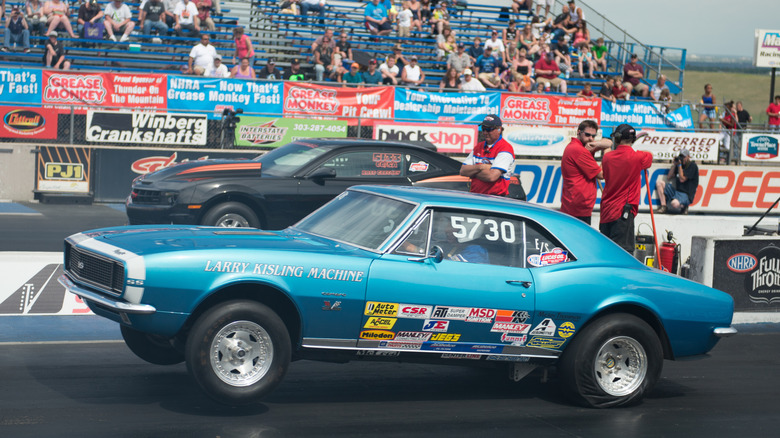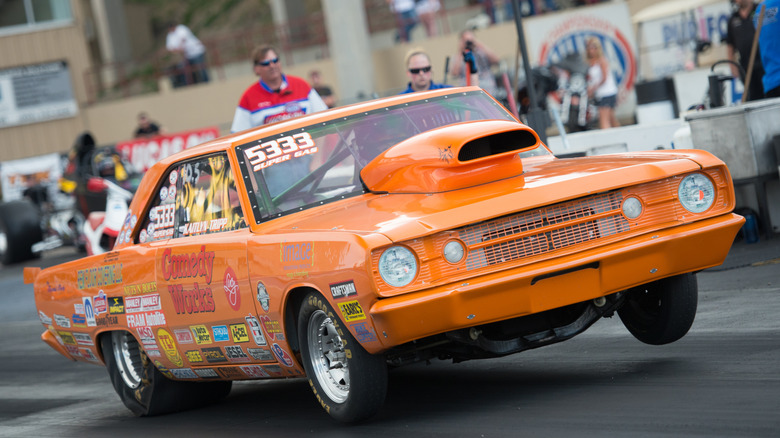What Type Of Fuel Do Drag Racers Use And Can You Use It In Your Daily Driver?
Top Fuel dragsters are without argument the fastest accelerating manned vehicles on Earth, boasting engines that are absolute marvels of engineering. Each V8 displaces 500 cubic inches, about the same as a Dodge Viper, but comfortably exceeds 11,000 horsepower. The name behind the classification, "Top Fuel," or "T/F" for short, provides a crucial clue into just how they produce that much power. It's a highly specialized racing fuel that actually has a surprising amount of uses outside of just making a car go extraordinarily fast in as little time as possible, but could one of those uses be as a regular car fuel?
Let's say you filled up your fuel tank with 20 gallons of Top Fuel-grade nitromethane. Aside from the fact that you just dropped about a grand on gas, would you need to pay for an engine rebuild as well? Would your car even combust it, or would it just refuse to start in the first place? What about mixing it 50/50 with regular 87 octane, or trying other fuel types used in drag racing? What sorts of fuels are even used in the highest levels of drag racing and why are they used there, but not your car (aside from the exorbitant prices)? Let's take a deep dive and find out. First, let's discuss how gasoline produces energy in the first place.
What is octane rating and why it matters
Typically, if you go to a gas pump, you'll see a sign denoting the fuel's octane rating and whether or not it contains additives like ethanol. Octane is measured with two numbers: MON and RON. MON (motor octane number) indicates a fuel's octane under heavy load, and RON (research octane number) measures octane under milder conditions. Your typical pump gas will sit between 87-93 AKI, or Anti-Knock Index, an average between the MON and RON. Many stations carry gasoline pre-mixed with E10 ethanol, which is 10% ethanol and 90% gasoline. Similarly, many modern cars are designed to also run on E85 ethanol as well (85% ethanol).
Like the original gas-powered "Gassers" of old, many dragsters continue running just straight pump gas, high-alcohol, or high-octane racing fuel, typically denoted by a "G" suffix on the vehicle classification. Largely, this fuel is not dissimilar from regular unleaded and will run in your car just fine as long as it's compatible with normal premium-grade pump gas.
Octane isn't actually a measure of a fuel's energy density, but rather its volatility under compression. Fuel with a lower octane rating is more prone to pre-ignite, causing engine knock due to early combustion. This is why leaded fuels were common in older engines—lead increases octane. Many modern cars have variable timing to help offset this problem, so you won't directly hurt the engine by putting in octanes not recommended by the manufacturer. All your car will do is advance or retard ignition based on how rich the fuel mixture is. Bear this in mind when we take a look at the next topic: nitromethane.
Nitromethane: Cramming power within even more power
Commonly referred to as "nitro fuel" or just "nitro," nitromethane is actually regularly used outside of drag racing, being mass-produced as an industrial solvent. Racing R/C cars use nitro fuel as well. This stuff is no joke, with early racers wearing distinctive fume masks during runs. It's actually not all that easily combustible, either; you could put out a match by dunking it in some nitromethane. The fuel used in NHRA's T/F class today is 90% nitromethane, 10% methanol, and other additives by composition. Like rocket fuel, nitro also carries its own oxygen supply, so it doesn't require nearly as much air to combust as gasoline. So, will it work in a regular car?
Well, unless your regular car happens to boast spark plugs that pull 44 amps apiece (drawing more power than an arc welder), you will never even reach the ignition stage, much less sustain an idle.
Nitro engines typically run extremely rich to allow auto-ignition from compression like a diesel. And they need to, since they run so hot that their spark plugs melt halfway down the strip. However, because nitro doesn't like to burn, it would simply lock up immediately or refuse to start in any engine, even in the dragsters themselves. T/F cars start on gasoline before switching on the nitro, to help get the engine primed. Similarly, it will never work in a normal engine. And if you manage to get it started on residual gas in the fuel lines before it gets to the nitro and you manage to burn it, you'll likely melt everything from your exhaust valve down because nitro burns both very slowly and very richly.
Could you just mix nitro into regular gas?
In certain proportions, a nitromethane additive can certainly increase performance in some engines, so long as the cars are tuned to handle the extra power. Why is that? Well, think of a combustion chamber like a container with two parts. Both parts need a very specific ratio to run right. Regular gas runs at 14.7 parts per one part of air. But nitro runs at 2.2:1, hence why no normal engine can run it.
By putting in nitro, you're effectively taking away space used for air because the nitro burns its own oxygen. So, the more nitro you put into a fuel tank, the more stable fuel will replace oxygen and the richer the engine will run. If you put in too much, you risk hydrolocking the engine with unburnt nitro. This is also why you see the "rooster tail" effect coming out of nitro-powered dragsters; the flame is unburnt fuel still combusting as it leaves the exhaust.
Plus, there's the durability issue. This fuel is designed to create huge amounts of power. T/F dragsters feature Kevlar jackets around the supercharger because the engines explode with alarming regularity. So, mixing nitro into a regular engine without any other tuning is not advisable. Cars are usually rated to run on specific octane levels, and gasoline and diesel have very well-known and predictable properties. But because nitro takes so much effort to detonate, it effectively sits in its own classification bracket. Mixing any fluid (combustible or not) that behaves differently from your car's designed parameters, in large enough quantities, is an excellent way to turn an internal combustion engine into an external combustion engine.
What about race gas?
Again, this depends on the car, but also the type of fuel and octane rating. Race gas represents the vast majority of fuel used in professional drag racing. Let's take one of the most popular on the market, VP Racing C10, as an example. This fuel is unleaded with no metal additives, which means it works with catalytic converters that would otherwise be damaged by leaded gas. It features a RON of 104 and an MON of 96, whereas typical premium gas is about 97 RON and 87 MON. That would actually work in your normal engine, though again, it wouldn't extract all that much extra performance out of it. Certainly not with something like C25 or other fuels with octane ratings exceeding 120 — these fuels were designed to operate in vehicles with far higher compression ratios than most cars. This also applies to diesels, which do have higher compression ratios, but are not designed to use gasoline in the first place (however, there is racing diesel fuel which is compatible).
Because race gas is essentially just regular gasoline designed to operate in a much more hostile environment, it'll have no issues operating in a normal engine. Typically, race gas also features no ethanol, which can degrade fuel components if it sits for a long time. Hence, it's recommended to use dedicated storage fuels or high-octane ethanol-free pump gas to store older vehicles long-term.
Other than making your wallet a lot lighter, though, not much is going to happen if you fill up with race gas. This is especially true for engines not designed to run on premium, or engines with no knocking issues. So no, filling your tank with unleaded race gas does not directly harm your engine, just your bank account.
Lastly, what about alcohols?
Let's say you somehow managed to get ahold of 20 gallons of race methanol and put it in your fuel tank. Methanol-blended fuels as high as 86% pure found uses in motorsport dating back to the interwar era and, with a proper setup, brought peak combustion temperatures down and led to substantial increases in performance. However, it came under scrutiny for its toxicity and for burning almost totally invisibly.
This fact led to numerous accidents, including setting Rick Mears and safety personnel on fire in an incident at the 1981 Indy 500. Hence, many racing series banned pure methanol as a fuel including IndyCar, but many options remain for methanol injection and it's still quite popular. Brands such as Holley and Nitrous Express, among many others, produce kits for regular combustion engines and see frequent use on the drag strip.
That said, methanol is also corrosive and toxic, and high amounts will potentially damage your engine's internal components as a result. But there are some upsides, namely in emissions, performance figures, and octane. Methanol is an excellent octane booster and produces far less emissions than ethanol, so in lower concentrations it will absolutely not harm your engine. Just keep it in low concentrations, otherwise you'll need to set up your engine to run it properly and might damage components such as fuel lines and injection systems due to the effects of corrosion.
As for ethanol, that's an easy one; you're likely already putting some in your fuel tank. Take a look at your local gas station's pump and you'll know exactly how much!
